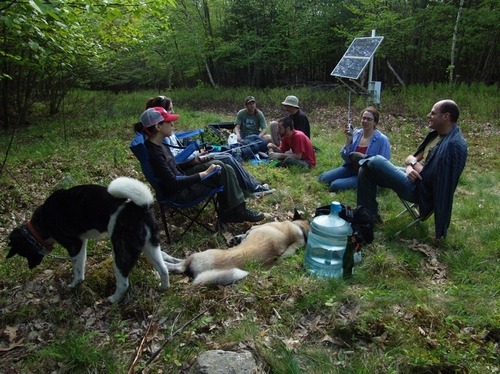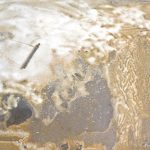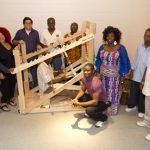Meet a NYFA Artist: Leila Nadir and Cary Peppermint (EcoArtTech)
Opening reception of ecoarttech’s installation Wild Info Net in the Upper Catskill Mountains
NYFA speaks with Leila Nadir and Cary Peppermint, 2009 Digital/Electronic Arts Fellows
NYFA: Hi Leila and Cary, please tell us a little bit about yourselves and what you’re currently working on.
LN/CP: We are an eco-art/theory collaborative and former New Yorkers now based in Rochester, NY. Leila’s academic training is in literature and Cary has made new media and performance-based art for over twenty years. We bring together our separate disciplines, histories, and practices through a shared interest in nature and the environment. For us, the “environment” encompasses a wide variety of networked systems, including biological habitats, global exchanges, industrial grids, digital networks, and the democratic imagination. Our works merge primitive with emergent technologies and navigate the intertwined terrain between nature, built environments, mobility, and electronic spaces. We are particularly excited right now about a residency program we are creating in the central Maine mountains where new media practitioners will be invited to make art in networked treehouses in the remote woods.
We are about to release the latest update to Indeterminate Hikes +, an Android app for smartphones that reimagines how we interact with everyday landscapes and computing technologies. Smartphones, generally, are devices of rapid communication and consumerism, designed to get you what you want and where you want as quickly as possible. Indeterminate Hikes + reappropriates this technology for a very different end, turning smartphones into tools of environmental imagination, meditative wonder, and slowing-down.The app works by importing the rhetoric of wilderness into virtually any place accessible by Google Maps and encourages its users to treat these locales as spaces worthy of the attention we accord to sublime landscapes, such as canyons and gorges. IH+ will be available for free on the Android Market and can be used by anyone with an Android phone. We also lead indeterminate hikes in interactive public performances as part of art festivals and exhibitions, leading hikers through sublime ecological experiences in unexpected locales. With IH+, the ecological wonder usually associated with “natural” spaces is re-deployed to renew awareness of the often-disregarded spaces in our culture that also need our attention.
NYFA: What is ecoarttech? When did this collaborative begin, and how has it evolved over time?
LN/CP: Ecoarttech began as an informal faux-academic online performance called “The Department of Ecology, Art, and Technology” around 2004; we shortened the name when we made our website ecoarttech.net. We were frustrated by how these three areas—environmental thought, art, and technology and new media studies—were so isolated from one other in academe, the “art world,” and popular culture. Nearly a decade ago, the assumption that eco-artists must work with sticks and rocks rather than new media was much more common than it is today, and environmental thinkers too often eschewed technology as the culprit of ecological degradation. In addition, the new media scene, both in and beyond art, rarely touched on anything environmental. The landscape has changed since then—but not enough. What has remained consistent in our nearly eight years of working together is our focus on the overlap between these areas: how to repurpose new media technologies and reimagine environmental relationships through aesthetic experiences.
NYFA: How do you two divide labor, who does what, or how do you work together?
LN/CP: After years of working and living together this is not so easily determined. We are fortunate in that we are motivated by one another. Usually one of us will seize a moment or take hold of an idea and then the other is ready to jump in to support or finish off what the other one has gotten themselves into.
NYFA:You speak often to the idea of networks, does this have an eco-systemic connotation for you? How are technology and ecology related?
LN/CP:When the term “network” is used, it is usually to refer to networked societies and digital technologies. We also see nature as a network, a biological network, and we think of social and economic modernization as the networking of society, creating uneven systems of mobility, commerce, and cultural exchange. As environmental artists who think about the connections between all living things, we see all these networks as flowing through one another. Art, culture, digital media, and even mental health are intertwined “ecosystems,” just as much as physical environments. We love Gregory Bateson’s illustration of this, especially since he cites one of the Great Lakes: “if Lake Erie is driven insane [by pollution], its insanity is incorporated in the larger system of your thought and experience.”
NYFA: What are some of the forms that your projects have taken?
LN/CP: Our Android app, Indeterminate Hikes+, provides hiking trails through the wilderness of urban spaces. In #TrainingYRHuman, domesticated animals tweet about their human companions. Untitled Landscape #5 data-visualizes the networked environmental impact of online “hikers” to the Whitney Museum of American Art website. Eclipse, a web-based application, explores the politics of pollution, the myth of wilderness, and the ecology of social networking sites. In Frontier Mythology, a solar-powered lean-to equips urban adventurers with the tools of the U.S. frontier to navigate the dense information-environments of mega-cities, and Wilderness Information Network provides sonic experiences for bears, birds, and trees on remote hiking trails. Even though we see our work as having a consistent thread—the exploration of modern environmental being—critics have placed us in a lot of different disciplinary categories: our work has been chronicled in publications on science, public art, transmission arts, sculpture, photography, networked performance, and internet art.
NYFA: How do you begin a project?
LN/CP: What if there was a ________ that grabbed dynamic data from a ________ and then converted it into ________ and people would participate via of a series of ________s that brought into question the idea of ________.
NYFA: Who or what has been influencing you recently?
LN/CP: Animals. Wild animals, farm animals, human animals, and our companion animals, Tuffy and Buster. On a research trip for an upcoming project, we were inspired by the diverse personalities we met at Farm Sanctuary, in Watkins Glen, an organization that works to protect farm animals from cruelty, change society’s views of animals, and promote compassionate vegan living. Some of the friends we made there include Freckles, a sheep who was quick to make friends with Cary and was a great photo-model; Orlando, a rambunctious calf who seems up for anything and who bit my backpack when I turned away from him to greet to his brothers; Lawrence, a young cow who smiles when you scratch the sides of his face; and Bob, who was very sleepy in a pile of hay when we visited but greeted us with grunts and made his pink pig belly available for rubs (we heard he also likes to play jokes). And though we didn’t befriend her, we very much respected Fiona, a pig who clearly communicated with her body language that she was cool with our visit as long as we left her alone.
As an art-theory collaborative we enjoy when creative experiences and chance operations intertwine playfully with critical thought. Perhaps a very fitting counterpart to our Farm Sanctuary day was the Animal Influence exhibition/conference we recently participated in at Emily Carr University in Vancouver, where artists and critics explored the emerging field of Animal Studies. Traditionally, the sciences have dominated the study of animals, and we are excited that the humanities are now taking the study of animal-ness seriously and challenging the long-held misperception that humans are special and not really like other animals. As eco-critic Timothy Morton said recently, “According to evolution science, there are two things humans do very well, but they are a bit of an ego blow: throwing and sweating. Everything else is also done by nonhumans, including consciousness, feelings, art, tool use.” As artists we have found that opening ourselves to animals’ consciousness and creativity shakes up our stale human behaviors and assumptions, providing an extraordinary creative stimulus. One of our recent works, #TrainingYRHuman, tries to document animals’ incredible agency in dealing with a human-dominated world.
NYFA: How did the NYFA Fellowship affect you?
LN/CP: The NYFA fellowship we received in 2009 connected us to a network of artists, opportunities, and organizations across New York State and has taught us about additional resources to support our career, including alternative modes of funding. In addition, although NYFA does not limit its fellowships to specific projects, the fellowship contributed to some of our living expenses during academic leaves we took to complete Eclipse, a commission for Turbulence.org. Because of the creative freedom NYFA fellowships enable and the resources the Foundation puts artists in touch with, we are always encouraging our friends to apply for the fellowships in order to get connected to the NYFA community.
For more information visit the ArtEcoTech website.





